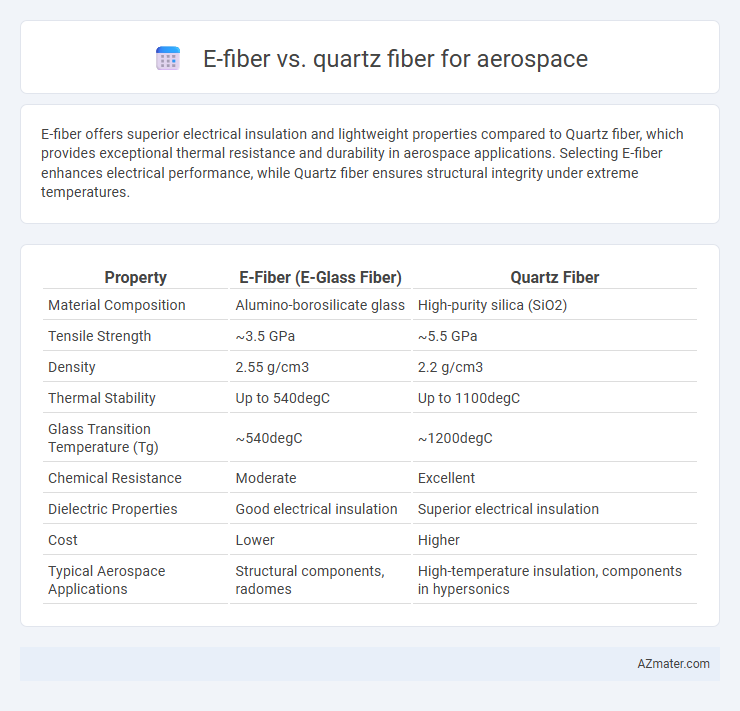E-fiber offers superior electrical insulation and lightweight properties compared to Quartz fiber, which provides exceptional thermal resistance and durability in aerospace applications. Selecting E-fiber enhances electrical performance, while Quartz fiber ensures structural integrity under extreme temperatures.
Table of Comparison
| Property | E-Fiber (E-Glass Fiber) | Quartz Fiber |
|---|---|---|
| Material Composition | Alumino-borosilicate glass | High-purity silica (SiO2) |
| Tensile Strength | ~3.5 GPa | ~5.5 GPa |
| Density | 2.55 g/cm3 | 2.2 g/cm3 |
| Thermal Stability | Up to 540degC | Up to 1100degC |
| Glass Transition Temperature (Tg) | ~540degC | ~1200degC |
| Chemical Resistance | Moderate | Excellent |
| Dielectric Properties | Good electrical insulation | Superior electrical insulation |
| Cost | Lower | Higher |
| Typical Aerospace Applications | Structural components, radomes | High-temperature insulation, components in hypersonics |
Introduction to Fiber Materials in Aerospace
E-fiber and quartz fiber are critical materials in aerospace engineering due to their exceptional strength-to-weight ratios and thermal stability. E-fiber, a type of glass fiber, offers excellent electrical insulation and tensile strength, making it suitable for structural reinforcement and lightweight composites in aircraft. Quartz fiber provides superior heat resistance and dimensional stability, ideal for high-temperature environments such as jet engine components and thermal protection systems.
Overview of E-Fiber and Quartz Fiber
E-fiber, primarily composed of alumino-borosilicate glass, offers excellent electrical insulation, high tensile strength, and cost-effectiveness, making it widely used in aerospace applications for structural and thermal management. Quartz fiber, made from high-purity fused silica, provides superior temperature resistance, low thermal expansion, and exceptional chemical stability, ideal for extreme aerospace environments such as high-speed aircraft and space vehicles. Both fibers enhance composite materials, but quartz fiber excels in high-temperature performance while E-fiber balances mechanical strength with affordability.
Mechanical Properties Comparison
E-fiber exhibits a tensile strength of approximately 3.5 GPa and a Young's modulus near 72 GPa, making it suitable for moderate mechanical load applications in aerospace structures. Quartz fiber, with superior tensile strength reaching up to 4.8 GPa and a higher Young's modulus around 85 GPa, offers enhanced stiffness and durability under extreme conditions. The lower density of E-fiber (~2.54 g/cm3) compared to quartz fiber (~2.65 g/cm3) contributes to weight-sensitive aerospace components, but quartz fiber's superior thermal stability and fatigue resistance often justify its higher mass in critical aerospace applications.
Thermal Resistance and Stability
E-fiber offers moderate thermal resistance withstanding temperatures up to approximately 600degC, while quartz fiber demonstrates superior thermal stability, maintaining integrity beyond 1,000degC. Quartz fibers exhibit exceptional resistance to thermal shock and chemical corrosion, making them ideal for aerospace applications requiring high-temperature endurance. The enhanced thermal stability of quartz fibers significantly improves the reliability and lifespan of aerospace components exposed to extreme heat conditions.
Electrical Insulation Capabilities
E-fiber offers superior electrical insulation capabilities compared to Quartz fiber due to its high dielectric strength and low electrical conductivity, making it ideal for aerospace wiring and electronic components. Quartz fiber, while highly resistant to temperature extremes and chemical corrosion, exhibits higher dielectric loss and lower resistivity, limiting its effectiveness in insulating high-voltage aerospace systems. The enhanced electrical insulation properties of E-fiber contribute to improved safety, reliability, and performance in aerospace electrical applications.
Weight Considerations in Aerospace Applications
E-fiber composites offer a significantly lower density of approximately 2.6 g/cm3 compared to quartz fibers, which have densities around 2.65-2.7 g/cm3, making E-fiber more advantageous for weight-sensitive aerospace structures. The reduced weight of E-fiber materials contributes to enhanced fuel efficiency and increased payload capacity in aerospace applications. Their superior strength-to-weight ratio and corrosion resistance are critical factors in optimizing the performance and longevity of lightweight aerospace components.
Durability and Longevity Under Stress
E-fiber composites exhibit enhanced durability and longevity under extreme aerospace stress conditions due to their superior tensile strength and resistance to fatigue compared to quartz fiber. Quartz fiber offers excellent thermal stability and corrosion resistance but tends to show reduced durability when subjected to cyclic mechanical loading and high vibration environments typical in aerospace applications. Optimizing material selection by prioritizing E-fiber composites improves structural integrity and lifecycle performance in aircraft components exposed to dynamic stress.
Cost Analysis: E-Fiber vs Quartz Fiber
E-fiber offers a cost-effective alternative to quartz fiber due to lower raw material and manufacturing expenses, making it suitable for budget-sensitive aerospace applications. Quartz fiber, although more expensive, provides superior thermal stability and durability critical for high-performance aerospace environments. Cost analysis shows E-fiber reduces overall production costs by up to 40%, while quartz fiber justifies its premium with enhanced long-term operational reliability.
Typical Aerospace Applications
E-fiber composite materials are favored in aerospace for structural components such as wing skins, fuselage panels, and engine nacelles due to their high tensile strength, electrical insulating properties, and cost-effectiveness. Quartz fiber is preferred in thermal protection systems, radar radomes, and high-temperature components owing to its superior thermal stability, low thermal expansion, and excellent dielectric properties. Both fibers contribute to weight reduction and enhanced performance, but E-fiber dominates in mechanical load-bearing applications while Quartz fiber excels in thermal and electromagnetic environments.
Future Trends and Innovations in Fiber Materials
E-fiber and quartz fiber are pivotal in aerospace for their lightweight and high-temperature resistance properties, with E-fiber offering exceptional electrical insulation and quartz fiber excelling in thermal stability. Future trends indicate a shift towards hybrid composite materials that combine E-fiber's strength-to-weight ratio with quartz fiber's heat endurance to enhance aircraft performance and fuel efficiency. Innovations in nano-engineering and surface treatments aim to improve fiber-matrix bonding and durability, driving the development of next-generation aerospace composites.

Infographic: E-fiber vs Quartz fiber for Aerospace
 azmater.com
azmater.com